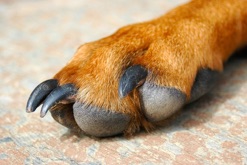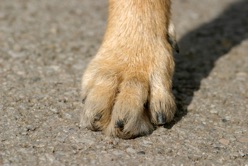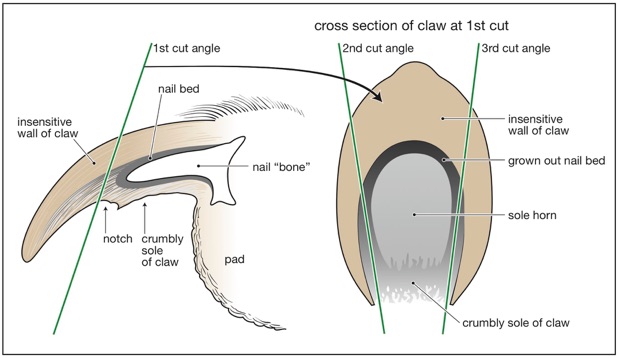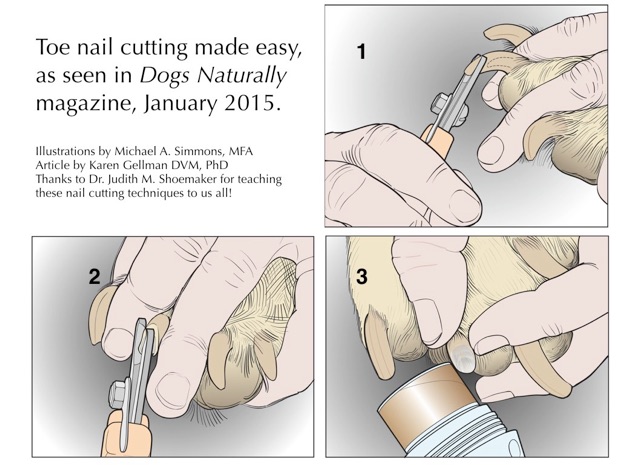A new way to trim nails-- that works!
as seen in Dogs Naturally Magazine, January 2015, pp16-19

A new way to trim nails-- that works!
as seen in Dogs Naturally Magazine, January 2015, pp16-19
Nothing brings a guilty look to the face of a dog owner faster than asking how often they cut their dog’s nails!! Even really conscientious owners, who go to great lengths for their dog’s social lives and nutrition, often admit “Not as often as I should.” Why is this true? And why does it matter?
The most common reasons for avoiding nail trims are that 1) the owner is afraid of “quicking” the dog, or 2) the dog fusses and creates bad feelings around the procedure. Nail cutting becomes an event surrounded by angst and drama. For very active dogs, who run all day long on varied surfaces, cutting nails may not be necessary. High mileage wears them down naturally (Photo: Normal Toenails). But among city or suburban dogs, who are lucky to get a mile or two walk daily, excessively long toenails are more common than not.
So what’s the big deal? The first consequence of long toenails is painful feet. When a dog’s toenails contact hard ground, like a sidewalk or your kitchen floor, the hard surface pushes the nail back up into the nail bed. This either puts pressure on all the toe joints, or forces the toe to twist to the side. Either way, those toes become very sore, even arthritic. When the slightest touch is painful to your dog, they will fuss when you pick up their paw to cut nails.
The second consequence of long toenails is more serious. All animals rely upon information from nerves in their feet to move through the world and process gravity accurately. For millions of years, wild dogs have run long distances while hunting, and worn their nails short. The only time their toenails would touch the ground was when climbing a hill. So a dog’s brain is evolutionarily programmed to associate toenail contact with being on a hill, and he shifts his body posture accordingly: leaning forward over his forelimbs, up the imaginary hill reported by his toes. Since the hill is not real, a secondary compensation with his hind limbs is necessary to avoid a face-plant. This abnormal compensatory posture can be called “Goat on a Rock”, because it brings their paws closer together under their body.


Normal neutral posture is a nice show dog “stack”, with vertical legs, like a table. Recent research shows that standing with limbs “camped-in” is hard work to maintain. These Goat-on-a-Rock dogs get over-used muscles and eventually over-used joints—especially in their hind limbs—making it difficult to jump in cars, climb stairs, and even hard to get up from lying down! Sounds like a lot of older dogs we know! Cutting toenails short can be like a miracle cure for your dog whose hind end has become painful, weak and over-used.
That’s the why. Now for the what and how. Toe nail maintenance requires a trim every 2 weeks- just like maintaining human fingernails. If you can hear nails click on your kitchen floor, they are much too long. But don’t despair— the technique shown here will make short work of getting your dog’s nails back to their correct shape. The concept is easy— trim around, never across the quick, which is actually your dog’s finger (Figure 1). Once the insensitive nail is thinned out, and not supporting the quick, the quick will dry up and recede, allowing more shortening. Each dog’s nails are different, but commonly, very long toenails become dry and cracked, with a clear separation of the living tissue and the insensitive nail. With the technique illustrated below, amazing things are possible.
Here’s what you need: Tools of the trade:
Nail Clippers:
Use only “scissor” type clippers. Guillotine style clippers crush the toe, which is painful. Never put the whole nail in a clipper.
Use small size clippers for better control. Only giant breed dogs will need large ones.
Keep your tools sharp— either replace or sharpen your clippers regularly
“Quick-guards” obscure your view of the nail. If possible, remove them, or at least tape them back so that they won’t interfere with your work.
“Pedi-paws” type grinder:
Smooth out your trim afterwards with a rotating emery board.
File only the insensitive nail around the top and sides of the quick: “Sharpen the pencil”, where the nail is the wood and the quick is the lead (see 3c).
Styptic or other wound powder
Staunch the bleeding in case you make a nail leak. With shallow cuts, this will be rare.
Easiest to apply to nail if using a small container with tightly packed powder

Always start with very shallow cuts, with the clipper almost parallel to the part of the nail you are cutting (Figure 1). In some dogs, the sensitive tissue is very near the surface and in others, further away. Using this method, it is possible to expose, but not cut the sensitive inner finger—the quick. Once you become skilled, the worst you will get is a tiny leak or ooze of blood. Keep a pot of styptic powder nearby, in case of accidents. It’s important to have a nice finish to your work. An inexpensive rotary grinder is perfect for this because the motor is too weak to cause any harm. Take off the “guard” so you can see what you are doing.

•Find a place to trim with excellent light.
•If you need “cheaters” for reading, use them for toenail clipping too.
•It’s actually easier to see the nail structures on pigmented nails than on white ones! The insensitive nail will show as a chalky ring around the sensitive quick.
•Keep clipper blades almost parallel to the nail— never cut across the finger
•Don’t squeeze the toes— that hurts! Use your fingers to separate the toes for clipping and hold the paw gently. Use a pair of blunt edged children’s scissors to remove excess toe hair— nothing dulls clippers quicker than cutting hair!
•Remember, no dog ever died from a quicked toenail! If you “quick” your dog accidentally, give a yummy treat right away.
•Use “constructional aggression”: keep attempting to do the work safely, don’t stop if your dog struggles. If she relaxes and cooperates, give her a break (and a cookie!)
•For maintenance, cut every 2 weeks. To shorten, cut every week.
Some dogs act like cutting their nails is their worst nightmare. This may be a learned behavior from their painful, overstimulated toes, which will slowly dissipate along with the pain once the nails are short. Use all your best restraint and behavior modification tricks to get through the initial phase, whether your dog is a squirmer or a drama queen. Start on the hind feet, because the nails tend to be a little shorter and less sensitive than the front. Good restraint is essential— you can’t make an accurate cut on a moving target. Get help if needed, and don’t hesitate to use a muzzle if your dog tries to intimidate you. Make nail trimming “quality time” you spend with your dog! Lots of kisses, lots of treats and a positive attitude go a long way! If you dread it, your dog will too, so learn how to be a good actor until you succeed in believing it can be loving for you both. If your dog loses patience quickly, try cutting one nail a day. As long as you keep the order of toes consistent, this will be a good maintenance schedule, giving every toe a trim every 16 days. Short toenails are critical to your dog’s health and soundness— Failure is Not an Option!
Thanks to holistic vet Dr. Judith M. Shoemaker (www.JudithShoemaker.com), for teaching this method to lucky colleagues and dog-owners around the world!!
Dr. Karen Gellman is known by colleagues worldwide for teaching and researching on posture, biomechanics and holistic veterinary medicine. She practices at The Wellness Center for Pets in Ithaca, New York, www.ithacapetwellness.com.